Architosh announces its 2019 AIA National BEST of SHOW honors, recognizing and drawing attention to the most exciting and innovative digital technologies shown at the show.
BEST of SHOW Introduction
The BEST of SHOW awards are designed to recognize the most interesting and promising technologies, making an impact on architectural practice in the United States and globally.
Winners of these small honors receive recognition and digital BEST of SHOW placards for display in marketing and promotions and permanent placement onto Architosh’s BEST of SHOW winner’s roster page.
A companion “perspectives on BEST of SHOW” feature article—as in years past—further discusses and highlights the winning solutions within the context of a broader set of themes about technology in architectural practice and AEC in general. Anthony Frausto-Robledo, AIA, LEED AP, editor-in-chief, and Pete Evans, AIA, senior associate editor, Architosh, walked the show floor, attended technology-centric sessions and events, and spoke to various industry peers about the trends pushing technology forward in architecture.
Brief Preface
AIA 2019 seemed to naturally build on the Architosh BEST of SHOW analysis (Perspectives) from 2018 around the work of Carlota Perez which we will discuss in the upcoming perspectives article. The innovations and developments this year also reflected the AIA 2019 conference theme as well. We witnessed a lot of evidence showing technologies extending BIM, CDEs, VR/AR (XR), AI/ML, PIM (and more) to the broadest definition of stakeholders and at a finer level of data than seen before.
This year’s awards reflect the collective, the inclusiveness, and diversity required, the granularity of data and information required to elevate design to its highest potential.
Robert Ivy, FAIA, in his closing remarks in Las Vegas, noted the significance of this theme, “We are going to see a lot more collective genius. …no single brain will be big enough to master the body of knowledge required to lead the future.” This year’s awards reflect the collective, the inclusiveness, and diversity required, the granularity of data and information required to elevate design to its highest potential.
Award Categories and Criteria
We have maintained our award categories this year from last year—acknowleding that tools on specific platform types are not as important in the age of connected anywhere, anytime, any device access. The democratization of user data and access to that data are important measures of evaluation in these awards, but not to the entire detriment of sheer innovation and disruption. New solutions often take time to expand and serve the broadest of audiences—particularly coming from startups.
Our award categories are designed to be broad and flexible, enabling us to honorably note a product across a range of categories if so warranted.
- Emergent Technology (emTech) Category Award — acknowledges industry potential for bleeding edge technology implementations that will offer “thematic” change for practice or create convergent technology paths and drive at synergistic directions for the industry.
- Innovation Category Award — acknowledges the most “promising” companies and products that are heralding innovative new directions in AEC software or hardware technologies, as measured by: (a) implementation quality, (b) acceleration of quality of solution, (c) quality of attack on addressing “pain points” in practice, and (d) fitting convergent technology paths and driving at synergistic directions for the industry.
- BIM Category Award — acknowledges both new or mature companies and products serving the BIM workflow industry transformation, touching down at any segment of the MacLeamy Curve where value gets added, as measured by: (a) implementation quality, (b) acceleration of quality of solution, (c) quality of attack on addressing “pain points” in BIM workflows, (d) adoption, extension and commitment to Open BIM philosophies so that data and toolchains are social and democratized to their fullest extent, and (e) fitting convergent technology paths and driving at synergistic directions for the industry.
- Mobile+Cloud+Web Category Award — acknowledges technology solutions (software or hardware) driving at full utilization of synergistic and maturing “cloud-to-mobile” and “cloud-to-web” technology stacks, exhibited or seen at the AIA convention, as measured by: (a) implementation quality and novelty, (b) acceleration of quality of solution, (c) quality of attack on addressing pain-points in AEC, and (d) fitting convergent technology paths and driving at synergistic directions for the industry.
Congratulations to the 2019 AIA BEST of SHOW honorees listed below.
Architosh AIA 2019 BEST of SHOW Awards
BEST of SHOW — EMERGENT TECHNOLOGY Category
Winners in this category represent emergent technologies (emTech) that are far from “center-market” and much closer to “edge-of-market.” This means they have the potential for bending the trajectory of technologies near them—including creating a convergence of disparate tech—or offering completely alternative thematic change within the industry. An example of such a thematic change would be node-base visual programming tools like Generative Components or Grasshopper when they first emerged. They both bent the trajectory of existing technologies and offered a wholesale thematic change in terms of how architects work.
Winner: Magic Leap One
Magic Leap One, the augmented reality (AR) headset, was shown at this year’s AIA and draw massive lines of folks wanting to put it on and give it a spin. AIA attendees signed their names on big wait lists to get a chance to see how this long-awaited and much-hyped headset worked. Unlike VR devices, Magic Leap One places 3D objects inside your physical world in the same manner as Hololens but without the bulk. The device feels like wearing glasses and the hardware schema relative to your body is compelling—no tethers, no base stations. “As an exhibit demo, Magic Leap was very impressive. There were three of us simultaneously manipulating a model—moving, removing, grabbing, collaborating—very cool!,” said Pete Evans, AIA, senior associate editor, Architosh. “We were taking apart an engine and the light field rendering technology and (inside out) tracking felt quite natural and remarkable.”
Magic Leap invested and partnered exclusively with VIM AEC (honored below) which indicates another vector forward for headset development and the AEC industry. “The Magic Leap system has been a critically held development (unicorn?) only recently commercially available and looks to be quickly making an impact in its utility and opportunities,” added Evans. “What’s interesting about the trajectory of this system is that the compute engine sits holster style on your hip with a shoulder strap,” adds Anthony Frausto-Robledo, AIA, LEED AP, editor-in-chief, Architosh. “Long term this engine will get quite small and light and what this means is we are really looking at a full computer system in an entirely different form-factor, one very suitable for human mobility and for AEC industry job site work.”
Winner: Station IX
Station IX is a complete physical environment similar to a VR cave but entirely different technologies. It supports sizes of different groups and the visualization was stunning and compelling. The sense of physically moving was very strong without the physical separation and discomfort inherent in headgear. Even without stereoscopic projection, the use of mirrors as the project surface creates a fidelity of reality unique to VR/AR collaborative technologies. “The photographic color depth, contrast, and resolution was really impressive with this high-end solution,” said Pete Evans, AIA, senior associate editor, Architosh, “being able to display ideas through this new immersive solution provides a new level of realization and clarity of understanding.”
“What they call a ‘true to life’ experience reminded me of the wonders of Disney technology at different times of my life. It offers a natural way to experience immersive environments with other colleagues, albeit at a completely different price structure,” said Frausto-Robledo. “This technology might be very appropriate for large distributed companies, for towns and cities and their urban community planning and review, and institutions of learning.”
Honorable Mention: No honorable mentions this year in the Emergent technology category.
BEST of SHOW — INNOVATION Category
Innovation category winners this year are introducing both brand new types of technologies, implementing superior quality of attack on known pain points using new innovative means, or demonstrating convergence within the industry that heralds promising new directions. The AEC industry is clearly in the midst of the “installation phase” of paradigm-shifting technologies. To round out a Carlota Perez set of terms, the full “deployment phase” of these technologies are still years out as the AEC industry waits for various convergences to play out their disruptions and settle fully. Once such convergence is the set of gaming technologies infiltrating the world of AEC pro software—what we dubbed the “game-ification” of architecture back in 2015. Gaming giants Epic and Unity are both heralding promising new directions in CAD industries.
Winner: Unity Reflect
Unity Reflect is the first big product coming out of the Autodesk and Unity partnership detailed from last year’s Autodesk Univerity. Both gaming giants—Unity Technologies and Epic with its Unreal Engine—have entered the professional CAD markets in the past year or so with an intensity not seen in the AEC industry since the first VR headsets. Multiple convergences of technology are layering on top of the AEC space and the game engine developers are best positioned to provide this layering. Game engines solve the pain point of getting BIM models into as many people’s hands as possible for greater stakeholder engagement and higher design resolution feedback and confirmation.
After installing the Unity Reflect plugin into Revit, with a single click of a button Revit BIM models is highly democratized for a project. Unity Reflect is an app for every device imaginable, including VR/AR headgear, offering full-spectrum engagement modalities for stakeholders. “Unity has put together packaged (vertical) solutions for AEC and ATM (Automotive Transportation Manufacturing) and the results are impressive,” said Pete Evans, AIA, senior associate editor, Architosh. “They are serious about AEC. These moves are vital to the democratization of BIM and easing workflow toward more valuable iterations and prototypes of digital design…even training ‘naturally’ in the environment before it exists. It’s very powerful.” reflected Evans.
Unity Reflect brings over metadata and geometry data from Revit into its clients, offers federated models support for AECO discipline engagement, full element and layer support for viewing exactly what you want and can easily move around 10 million polygon models in real-time. “Unity’s roadmap looks impressive for Unity Reflect,” added Anthony Frausto-Robledo, AIA, LEED AP, editor-in-chief, Architosh. “The company will deliver APIs that will enable more applications to interact with the Reflect environment, and plans for voice and annotation will enrich concurrent BIM model viewing with physically dispersed stakeholders on a variety of devices.”
Winner: GRAPHISOFT ARCHICAD 23 and BIMx
GRAPHISOFT held its own key client conference (KCC) in Vegas just ahead of AIA and did a full unveiling of the latest version 23 release, including updates to its mobile platform, BIMx. Their upcoming releases for this year were also in their booth at AIA Vegas. This year we have awarded specific technologies for their innovations and power to herald new directions for the solution’s clients and the industry in general.
In particular, we are deeply impressed with the next-gen BIMx engine and direction to take BIMx to the web browser. GRAPHISOFT has also gone deeper with integration to Rhino and Grasshopper, enabling Rh+GH to access element surface geometry back in ARCHICAD to power more complex interactions through visual scripting and tap into the vast ecosystem of Rhino+Grasshopper extensions and tools—like Ladybug which performs detailed environmental climate analysis for building performance.
Firstly, the next-gen BIMx is a product of BIMx Lab. The app is actually available today for use, parallel to the current version of BIMx and BIMx Pro. The big innovation in the nex-gen BIMx Engine technology and its support for essentially unlimited BIM model sizes. BIMx Lab app is tremendously faster at loading BIM models because its new 3D engine uses “geometry streaming” technology. This means it streams into memory only the part of the BIM model that is visible, handling this dynamically in real-time. Even three-year-old iPad minis can load 50 million polygon models. Today’s powerful iPad Pro tablets will be able to vastly improve on that. If that isn’t enough, GRAPHISOFT is bringing BIMx to the web browser with the same features as the mobile version. “Seeing BIMx’s patented dynamic drawings to BIM model section technology working on the web browser was exciting. As mentioned when BIMx has first introduced years ago, it makes the relationship between drawings and BIM models extremely tangible,” said Anthony Frausto-Robledo, AIA, LEED AP. BIMx in the browser will also support game console controller support, but it massively democratizes BIM while simultaneously supports game-ification features that make the experience of interacting with BIM models very charming and engaging.
Honorable Mention: Unreal Game Engine (Epic)
Epic deserves honorable mentions at AIA Vegas, the company only weeks ago announced its acquisition of Twinmotion (an Architosh BEST of SHOW winner last year) and has hundreds of thousands of downloads of its Unreal Studio product for CAD industries. “Unreal’s acquisition of Twinmotion this summer reinforces the game-ification and real-time advantages of game engines and tools for AEC that will have serious consequences for both industries going forward,” said Pete Evans, AIA, senior associate editor, Architosh. “The importance of gaming technology was very clear and present at the AIA conference this year. ” Both Epic and Unity have product release plans for this fall. Unity Reflect is releasing in the Fall. New versions of Unreal Engine technology are also releasing this fall. The AEC industry has two titans from the gaming industry in an arms race of sorts fighting to win over the best software product lines and their customers in AEC. The big winner from all of this is the entire AEC industry but architects, in particular, will soon be experiencing a democratizing of visualization skills. That will importantly benefit building owners who pay the price (bills) for not understanding project plans, make changes, and paying for expensive change orders.
BEST of SHOW — BIM Category
This year we have multiple winners. Last year we focused a bit on “design-to-fabrication,” a convergence theme that on Gartner’s Hype cycle (see chart image here) is arguably farther back than the game-ification of architecture. The popularity of VR headsets and Apple’s ARkit technologies in their iPhones—consumer technologies first, pro technologies second—means game tech has moved off the edge-of-market and entering mainstream use by architecture firms. Therefore, in looking at the BIM tool suites, we have turned our attention to convergence themes farther along in the adoption cycle. We are also looking at an impressive acceleration of quality of solution (b criterion), particularly in reference to convergence themes.
Winner: Vectorworks Architect 2019
Vectorworks Architect 2019 has struck a high-point this year, particularly after its mid-year updates. The BIM application, often revered for its industry-leading 2D graphics capabilities, was early to market with IFC 4 RV V1.2 certification. It also advanced its Revit import capabilities, added BCF, and integrated, via a plugin, real-time interactive rendering with the industry’s leading and most popular interactive rendering package, Lumion. It also added 3D site model sculpting and direct editing of contours, along with AR tools in its mobile app, Nomad, in addition to immersive rendering technologies that work in democratizing environments like web browsers. “Vectorworks 2019 this year produced a very nice blend of updates, but the addition of live-linked connections to Lumion coupled with a suite of Open BIM and Revit support features truly boost this package’s appeal to architects and other design professionals,” said Anthony Frausto-Robledo, AIA, LEED AP, Architosh. “Vectorworks is attacking the convergence themes at every angle, including AR tools in its mobile app, but a killer new set of features may be getting lost in the mix and this involves their site model sculpting features—highly useful to landscape architects, urban designers, and architects in general.”
Winner: Bentley OpenBuildings Station Designer
OpenBuildings Station Designer introduces a thematic change in BIM tools—”building type” specific BIM design packages. In this case station design for rail and metro. A one-stop shop delivers comprehensive BIM technology formerly called AECOsim, combined with LEGION pedestrian simulation technology, a critical need for this building type range. Additionally, the product can support all AEC disciplines in a single package, supporting deliverables using the foundational Microstation technologies embedded in the solution, coupled with its native Generative Components for generative, computational design. “Bentley’s new OpenBuildings Station Designer combines AECOsim technology based on Microstation with LEGION modeler for pedestrian simulation, giving architects and other design professionals planning rail and metro stations comprehensive analysis and simulation tools for this complex building type,” said Anthony Frausto-Robledo, AIA, LEED AP, editor-in-chief, Architosh. “Unlike a generic BIM tool, OpenBuilding Station Designer contains workflow and assets specific to rail and metro station design, including connections to OpenRail and OpenRoad for coordinated design integration with connected infrastructure. Bentley’s new direction reflects its ambitions to provide digital twin technologies to the infrastructure market.”
Winner: GRAPHISOFT ARCHICAD 23
GRAPHISOFT has delivered several innovations this year that make its BIM software notable. In regards to convergence themes further along in the adoption cycle, AC 23 this year advances its BIM’s connections to the leading algorithmic visual-scripting modeling tool in Rhino-Grasshopper. Deeper connectivity with Rhino-Grasshopper enables BIM element “surface geometry” values to communicate back to Rhino-GH, from which the node-based visual-scripting tool can computationally generate both new forms but more importantly connect to Grasshopper’s vast ecosystem of plugins and extensions. This means tools like Ladybug, for example, which performs environmentally-informed design analysis on building designs to help architects develop more energy efficient structures, can become integrated into the ARCHICAD 23 workflow. “Architects on ARCHICAD 23 will gain a substantial computational design ecosystem from the world of Rhino+Grasshopper, with world-class analysis tools and much more,” said Anthony Frausto-Robledo, AIA, LEED AP, Architosh. “This may help more architects embrace computational design and the many benefits that come with it,” adds Frausto-Robledo.
Honorable Mention: No honorable mentions this year in the BIM category.
BEST of SHOW — Mobile+Cloud+Web
Perhaps no other category reflects the underlying digital revolution that is mobile+cloud. Cloud computing and smart mobile devices have revolutionized all of computing. In AEC they have sped-up and created novel new workflows increasing client expectations and shortening project delivery schedules. Architectural practice has been liberated from CAD/BIM workstations and desks to anywhere, anytime, on any device access to your data or SSoT (single-source of truth). Of particular note, this category evaluates CDE (common data environment) applications which are central to a democratized access to a single source of truth (SSoT).
Winner: Layer App
Layer is a brand new app and is highly engaging in its use of mobile+cloud+web technologies, using portable Javascript (Angular JS) tools to enable rapid implementation and support on multiple platforms. Layer supports JSON API for integrations with tools such as Asana or other SaaS in the browser tools and integrates deeply into Revit for real-time data flow between spaces in Revit and data for those spaces. Supports all three AEC players from Design, Construction through Operations. Excellent use of UX/UI and modern web social technologies and methods of working (eg: hashtags, etc). Works on a per-element basis for pricing with unlimited projects, or buildings. “I had the good fortune of attending the session that explained the history behind this brand new application, developed with remarkable clarity of focus,” said Anthony Frausto-Robledo, AIA, LEED AP. Architosh. “Layer is one of the smartest applications I’ve seen in years, making great use of modern technologies in both modern hardware and software, offering a flexible project management system that works from design, construction, down to operations phases,” adds Frausto-Robledo.
Layer app can function on its own but works best through a plugin extension to Revit, connecting it to a BIM application. The company said it could connect to the BIMs in the future. Clicking on “spaces” in Revit, Layer instantly loads all valuable building data, including photos, files, and tasks associated with that space. It also features smarter meeting minutes, with Layer Smart Docs which let you hashtag elements and people in your notes. Clicking on those hashtags takes you directly into the Layer app system displaying relevant data around the element or person tagged, even if the notes have been copied into email. “An amazing aspect of Layer is the ability to custom it to your exact needs, creating any type of data field to be filled out, complete with UI/UX data field options like sliders or text input fields,” adds Frausto-Robledo, AIA, LEED AP. Architosh. “Layer is an interesting new application that is fundamentally in the CDE category, it’s customizability is just one aspect, among several others, that sets it apart. We are excited to watch this app grow.”
Winner: Autodesk BIM 360
BIM 360 is aiming to be the preferred backbone for connecting everyone from design to owners in one place in an SSoT (single-source of truth) CDE. Autodesk has also acquired PlanGrid a popular SaaS tool with new BIM features recently added. Among both systems, Autodesk BIM 360, has deeper tools and more nuanced workflows, including more mature BIM model capabilities. “BIM 360 provides comprehensive role-based functionalities for the entire AECO team,” said Anthony Frausto-Robledo, AIA, LEED AP, Architosh. “Design package coordination and change visualization are superbly worked out in BIM 360, enabling users to understand multi-discipline changes over time.” Autodesk BIM 360 is a CDE (common data environment) that is optimized for Revit users with its BIM viewing tools. Other document types are supported within the CDE itself for both drawing sheets and backup data like photos, cut sheets, etcetera. Earlier in the year BIM 360 introduced construction cost management tools, making it more attractive to contractors.
Honorable Mention: VIM AEC
VIM AEC aims to completely democratize BIM and has an exclusive partnership with Magic Leap. Their booths at AIA Las Vegas sat side-by-side. The system uses the Unity engine and aims to automatically create the lightest weight BIM models that can be shared to all platforms, device types, including VR/AR headgear. When viewed through a web browser, VIM AEC presents BIM models that provide viewing control, transparency, white-mode, and data from objects. Users can adjust lighting levels and add Vnotes to the BIM environment. Magic Leap has made a significant investment in VIM AEC, the latter making a commitment to support Magic Leap’s spatial computing platform. Skender is an important early customer and user.
More at the companion annual convention “perspectives” article which will be published in the days ahead. Please also look for our AIA show floor and technology sessions reports coming up later this week. This article had contributions from Anthony Frausto-Robledo.
[Editor’s note: We wish to make clear that there are multiple winners in all four categories and no honorable mentions in Emergent and BIM categories.]

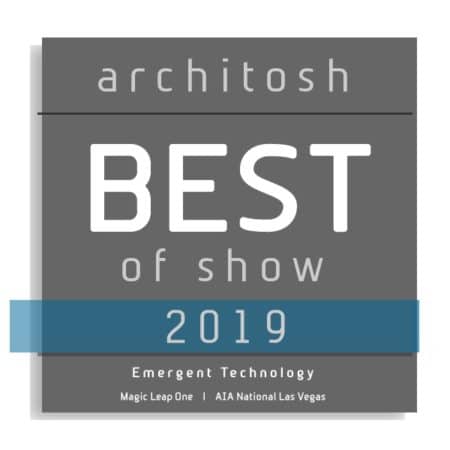
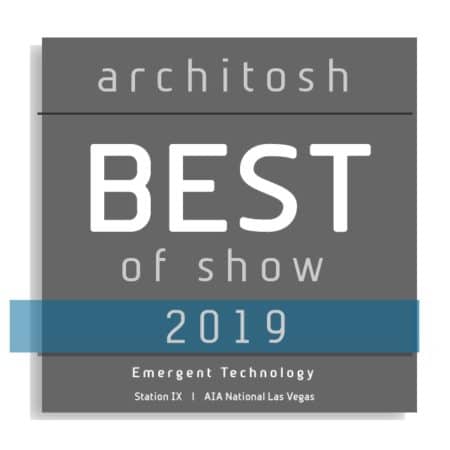
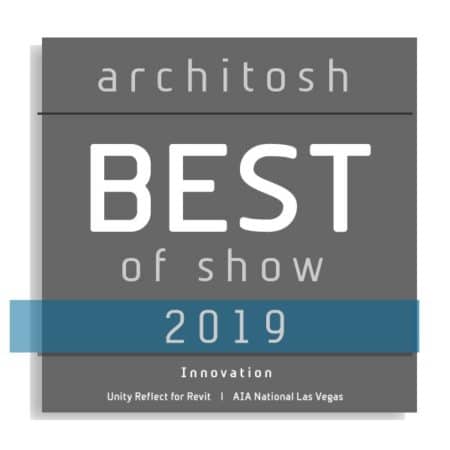

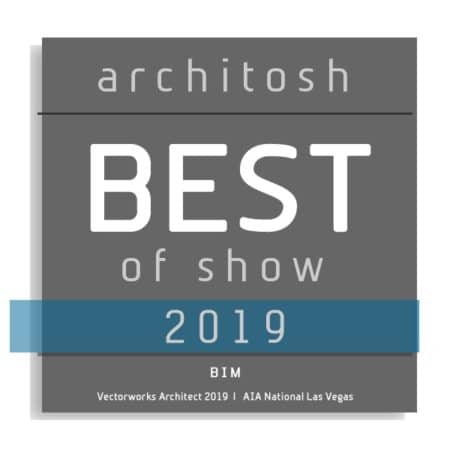
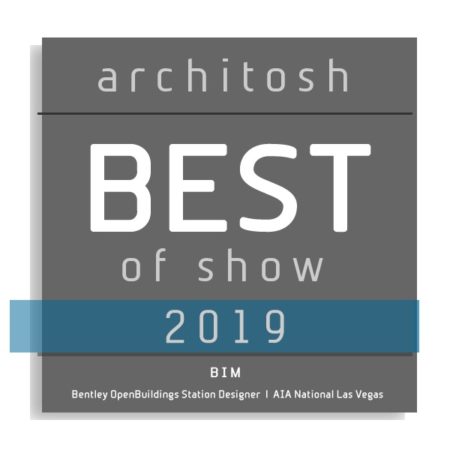
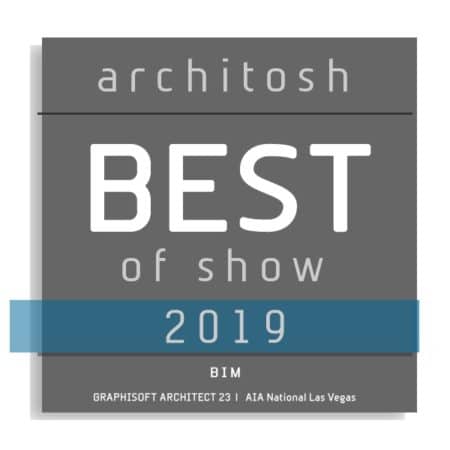

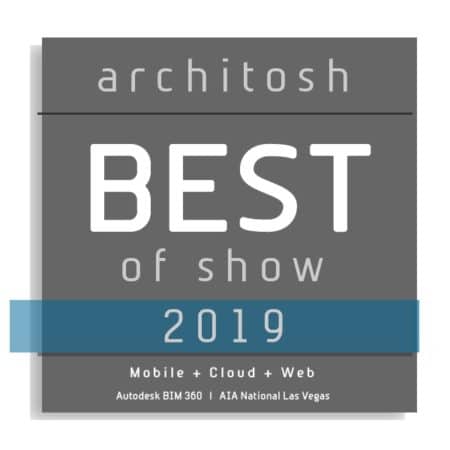


Reader Comments
[…] Read more about the Architosh Best of Show Awards here. […]
[…] Architosh awarded Unity Reflect “Best of Show – Innovation” at A’19, calling it “vital to the democratization of BIM.” […]
[…] Architosh awarded Unity Reflect “Best of Show – Innovation” at A’19, calling it “vital to the democratization of BIM.” […]
Comments are closed.